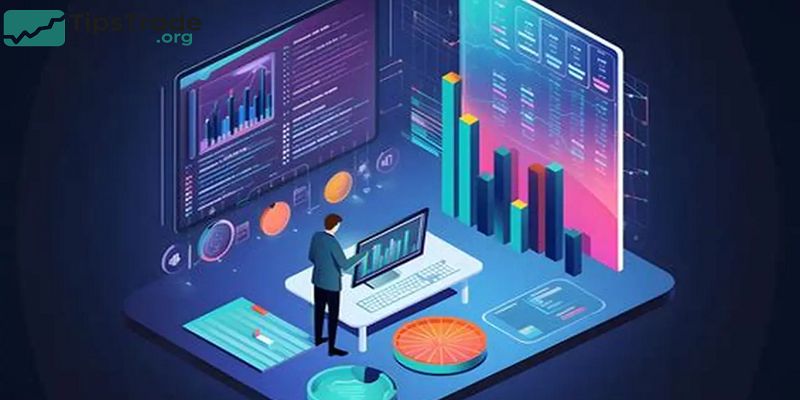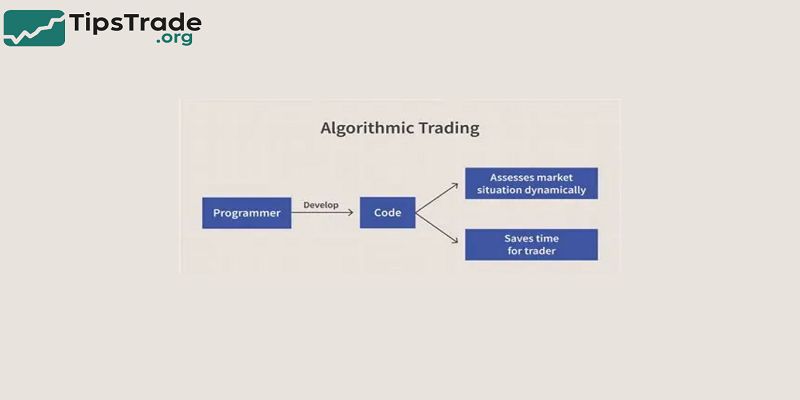Algorithmic trading often called algo trading or automated trading—has transformed how modern financial markets operate. In simple terms, it involves using computer algorithms to execute trades automatically based on predefined rules such as timing, price, volume, or mathematical models. Instead of humans manually placing trades, machines do it in milliseconds, bringing efficiency, discipline, and scalability. The article above from Tipstrade.org has just provided you . We hope that you find it useful. Wishing you successful trading!
What Is Algorithmic Trading?
- Algorithmic trading refers to the process of using computer programs to automatically execute trading instructions. These algorithms follow a defined set of rules—such as entry and exit conditions—based on data, analytics, or mathematical models.
Definition and Evolution
- Originally developed by institutional investors and hedge funds in the 1980s, algorithmic trading gained traction as technology improved.
- Today, both institutions and retail traders use automated systems to capture small inefficiencies or follow trends without emotional bias.
- According to JP Morgan’s 2024 e-Trading report, over 65% of total equity trading volume in the U.S. is algorithmically driven.
How It Works
The process typically follows these steps:
- Signal generation: identifying trading opportunities from data or indicators.
- Order execution: sending buy/sell orders via APIs or trading platforms.
- Risk management: setting stop-loss or exposure limits automatically.
- Monitoring and optimization: continuously improving the algorithm.
Types of Algorithmic Strategies
- Trend-following: based on moving averages or momentum.
- Mean reversion: betting that prices revert to their average.
- Arbitrage: exploiting price differences across markets.
- Market-making: providing liquidity by quoting both bid and ask.
- Statistical models: using quantitative patterns to predict short-term moves.
Key Components of an Algorithmic Trading System

A functional algo trading system isn’t just code—it’s an ecosystem of data, logic, and infrastructure working together.
Market Data and Feeds
Quality data is the backbone. Traders use:
-
Historical data for backtesting.
-
Real-time market data for live execution.
-
Tick data for high-frequency models.
-
Reliable data providers include Bloomberg, Refinitiv, Quandl, and Polygon.io.
Signal Generation and Model Logic
At this stage, the algorithm defines what triggers a trade. Examples:
- A moving-average crossover (e.g., 50-day vs 200-day).
- A statistical anomaly detected by regression or machine learning.
- News or sentiment analysis processed by natural language models.
Backtesting and Simulation
- Before going live, strategies are tested on historical data to assess profitability, drawdown, and Sharpe ratio.
- Good backtesting includes realistic transaction costs and slippage. Tools like Backtrader, QuantConnect, or Zipline are commonly used.
Execution & Order Management
- Once a signal occurs, the algorithm sends orders through an Order Management System (OMS) or Execution Management System (EMS).
- Efficient order routing reduces latency and improves fill rates.
Risk & Money Management
Key risk rules might include:
- Max position size: 2% of capital per trade.
- Stop-loss triggers at specific drawdown levels.
- Daily max loss limit to prevent runaway losses.
Infrastructure & Latency Considerations
- For high-frequency trading (HFT), milliseconds matter. Professional traders colocate servers near exchanges (like NYSE or NASDAQ) to minimize delay.
- Cloud-based VPS solutions offer affordable options for retail traders.
Common Algorithmic Trading Strategies
- There’s no one-size-fits-all approach. Below are popular strategy families used by professionals and hobbyists alike.
Trend-Following & Momentum Strategies
- These models ride ongoing price trends. For instance, if the 50-day moving average crosses above the 200-day, the algorithm opens a long position.
- Studies show that momentum strategies have delivered annualized excess returns of 6–8% in major equity markets (Jegadeesh & Titman, 1993).
Mean Reversion / Statistical Arbitrage
- Prices often revert to their mean after short-term deviations. A mean-reversion algorithm buys undervalued assets and sells overvalued ones based on z-scores or Bollinger Bands.
Market-Making Algorithms
- These provide liquidity by continuously quoting both sides of the market. Profits come from the bid-ask spread.
- It requires high-speed infrastructure and precise execution.
High-Frequency Trading (HFT)
- HFT strategies exploit micro-inefficiencies in milliseconds.
- While dominated by institutions, some retail traders simulate simplified versions using cloud servers.
Machine Learning / AI-Driven Algorithms
- Modern algo trading increasingly uses machine learning models to detect complex patterns in price, volume, or sentiment.
- Tools include Python libraries like scikit-learn, TensorFlow, and PyTorch.
Development Pipeline of an Algorithmic Strategy

Building a trading algorithm follows a systematic process—from idea to live deployment.
Research & Idea Generation:
- Start by formulating a hypothesis (e.g., “momentum works better during high volatility”).
- Gather data from equities, forex, or crypto markets to validate the idea.
Prototyping / Model Building
- Code the logic in Python or R. Use libraries like Pandas for data manipulation, NumPy for math, and TA-Lib for indicators.
Backtesting & Walk-Forward Testing
- Evaluate the strategy on past data. Use out-of-sample and walk-forward testing to avoid overfitting.
Paper Trading & Simulation
- Before going live, simulate real-time trading without risking money.
- Most brokers offer “demo accounts.”
Deployment & Live Monitoring
- Run the bot on a VPS or cloud server.
- Continuously monitor for execution errors, latency, and performance metrics.
Maintenance & Optimization
- Markets evolve, so algorithms must adapt.
- Use parameter tuning, feature selection, and periodic retraining to keep performance consistent.
Risks and Challenges of Algorithmic Trading

While automation brings efficiency, it also introduces new risks.
Overfitting & Data Snooping Bias
- A common mistake is designing a model that fits historical data too well but fails in live markets. Always test on unseen data.
Latency & Slippage
- Execution delay or poor network quality can cause trades to fill at worse prices.
- This erodes profitability, especially for HFT.
Market Regime Shifts
- What worked in a bull market may fail during crises.
- Algorithms must adapt dynamically or pause when volatility spikes.
Infrastructure Failures
- Power outages, API bugs, or broker disconnections can cause missed trades or duplicate orders. Redundant systems help mitigate this.
Regulatory & Compliance Risks
- Authorities like the SEC, CFTC, and ESMA regulate automated trading.
- Traders must comply with reporting and anti-manipulation rules.
Tools, Languages, and Platforms
Programming Languages
- Python – most popular for prototyping and research.
- C++ / Java – used for high-speed execution.
- R / MATLAB – preferred for quantitative research.
Frameworks & Libraries
- Backtrader, Zipline, QuantConnect – for backtesting and live trading.
- ccxt – connects to crypto exchanges.
- PyAlgoTrade – easy-to-use library for beginners.
Data Providers & APIs
- Alpaca, Interactive Brokers, Binance API, Polygon.io, Quandl
- These offer both historical and live market data streams.
Infrastructure Options
-
Cloud (AWS, Azure, GCP) – scalable for model training.
-
VPS / co-location – for low-latency execution near exchanges.
Conclusion
Algorithmic trading is reshaping the global financial landscape. By combining data science, programming, and financial theory, traders can make smarter, faster, and more disciplined decisions. However, success demands continuous learning, proper risk management, and ethical practice. Whether you’re a retail trader automating simple signals or an institutional quant developing advanced machine learning models, mastering algorithmic trading offers a competitive edge in today’s digital markets.

